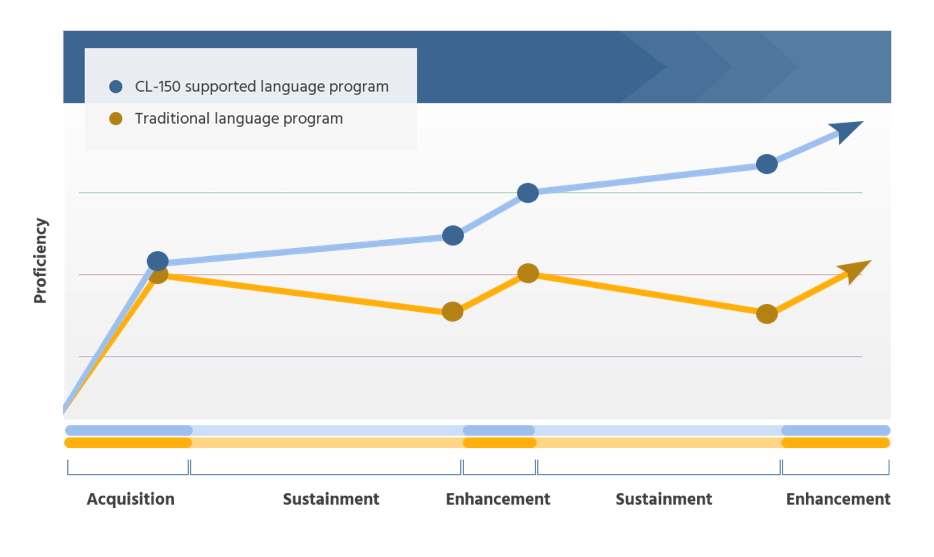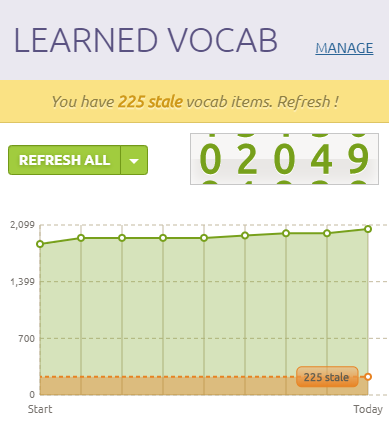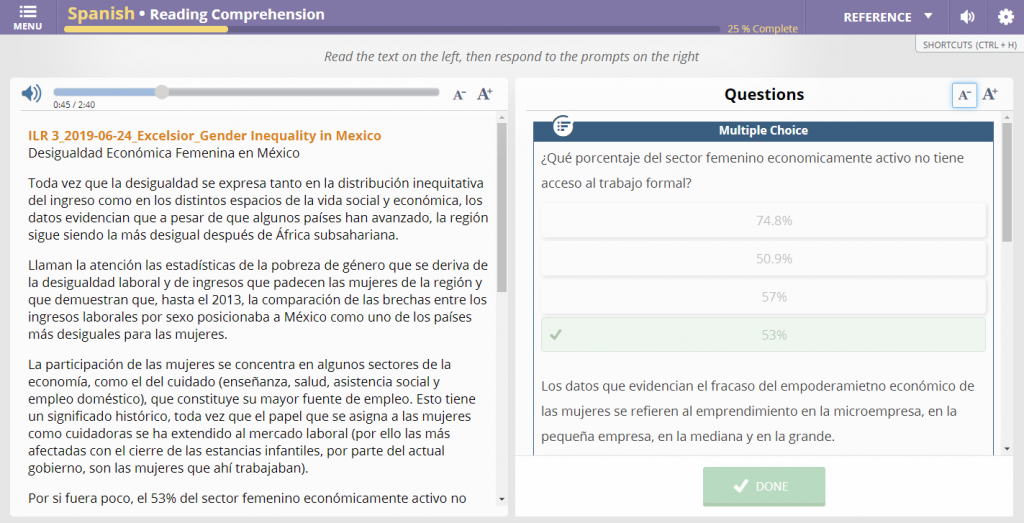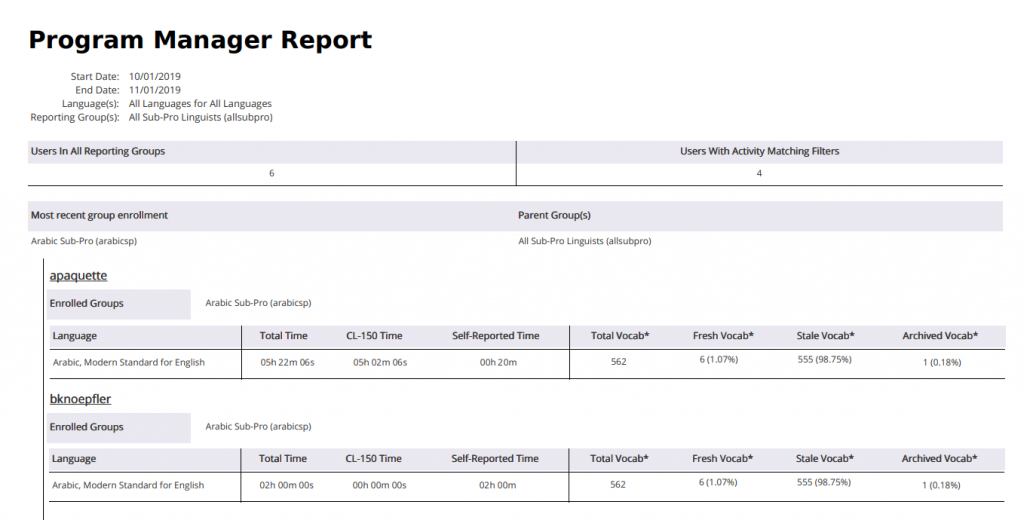Prevent Proficiency Drop-off Posted by meaghan on Dec 4, 2019 in For Program Managers
How can you, as a program manager, ensure that your team’s language skills are maintained and improved career-long, avoiding the nearly inevitable cycle of proficiency drop-off and costly re-training?
In other words, how can your language program make the transition from the yellow line to the blue line in the chart below? That was the topic of our sessions at ACTFL 2019 (slides available here).
Our answer to the proficiency drop-off problem: structured sustainment.

Structured Sustainment Framework
It is challenging for language professionals to set aside the time, find the right resources, and hold themselves accountable with so many competing obligations. To maintain proficiency outside of a formal training event (acquisition or enhancement) you need to provide your sustainers with structure.
Structured sustainment, as we see it, follows a simple framework:
- Identify organizational and individual proficiency requirements: It’s important to understand organizational language needs (the map of billets or positions, languages, and levels needed for the mission), but individual language requirements (expectations for sustainers) are the foundation for structured sustainment. Defining and supporting individual requirements ensures your sustainers will be fully effective on the job.
- Create a flexible, measurable, and enforceable sustainment policy: To set expectations, formally define your requirements in a sustainment policy or similar written guidance that can be referred to and refined over time. When you clearly communicate individual requirements, your sustainers will know what to do on a daily, weekly, and monthly basis—and actually follow through.
- Track to enforce the policy and measure language readiness: When you regularly track sustainers’ activity and enforce requirements, you can create accountability, increase motivation, and identify any need for intervention.
Structured Sustainment with the CL-150 Platform
How can you execute this three-step framework—and how can the CL-150 Platform help?
1. Identify required proficiency
This step is up to you and your language program, but you can refer to your organization’s guidance (for example, a DoD Instruction or equivalent civilian organization instruction). It’s important that program managers understand not only the larger organizational needs, but also consider the proficiency level required for individuals to be fully effective on the job.
2. Create a sustainment policy
A successful sustainment policy should answer two questions: what and how much. What should sustainers be doing on a daily, weekly, or monthly basis to maintain proficiency and how much time should they spend completing those tasks?
Those questions are best answered by each individual program, depending on the required proficiency identified in step 1, but the CL-150 Platform provides options for daily, weekly, and monthly engagement that can be incorporated into any sustainment policy.
- Daily Learned Vocab Refresh: The CL-150 Platform keeps track of all words and phrases a user learns (via Cohorts and other lessons), and regularly resurfaces vocabulary at risk of
 being forgotten. Ten minutes each day reviewing their Learned Vocab adds up to roughly 40 hours per year!
being forgotten. Ten minutes each day reviewing their Learned Vocab adds up to roughly 40 hours per year!
- Weekly Cohort lesson: CL-150 Cohort lesson streams provide sustainers with a new, level-appropriate, professionally-relevant lesson each week. If sustainers complete each week’s lesson, which should take 2-3 hours, that adds up to 140+ hours per year! With 15-20 new vocab items per lesson, that’s approximately 1,000 new, relevant words and phrases acquired (and refreshed) per year.

- Monthly self-reporting and assessments: We know that not all sustainment time happens in the CL-150, but that time still needs to be visible. Sustainers should periodically record external time using the self-reporting tools. Sustainers should also periodically take assessments to benchmark their progress. The CL-150 Platform includes open assessments in many languages, which sustainers can take to informally gauge where they stand at any given time.
3. Track to enforce and motivate
All activity in the CL-150 Platform is tracked and reportable to the sustainer and the program manager. Tracking increases motivation and highlights opportunities for intervention. It allows you to effectively manage and accurately report at the program level.
With a few clicks, you can run a Program Manager Report to see sustainers’ efforts, including learning time (time spent in the CL-150) and self-reported time (time spent elsewhere, but reported in the CL-150). This real-time oversight helps you quickly identify sustainers who are falling behind, making it possible to provide additional support (increased sustainment hours, a mentorship program, etc.) to those who need it, before significant proficiency loss can occur.

For your sustainers, CL-150 lessons provide the flexibility and relevance to be motivating and engaging, covering current events that language professionals will want to understand to maintain regional and cultural expertise.
For program managers, structured sustainment on the CL-150 Platform removes much of the administrative burden while increasing visibility. Minimal admin set-up is required for maximum oversight, so you can effortlessly identify sustainers at risk of falling below the required proficiency and prevent proficiency loss.
A more effective sustainment program starts with theory, but in practice, CL-150 supported sustainment programs are already improving outcomes for USG language programs:
“We haven’t had a proficiency test failure in 170 days, which is a testament that the CL-150 Cohorts and Reporting works.”
“One of our sub-pro Arabic linguists enrolled in your MSA Cohort and went from a 1+ on reading to a 3 within 3 months.”
“The CL-150 and Cohorts are an integral part of our program.”
Ready to provide your sustainers with the structure they need to prevent proficiency drop-off? Let’s talk: usg@transparent.com.


